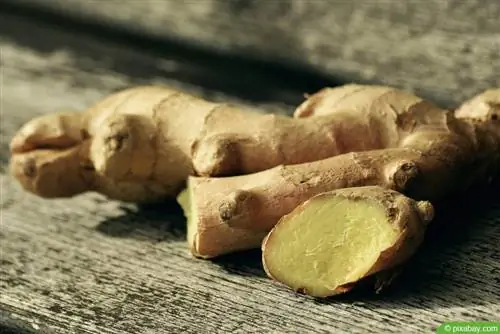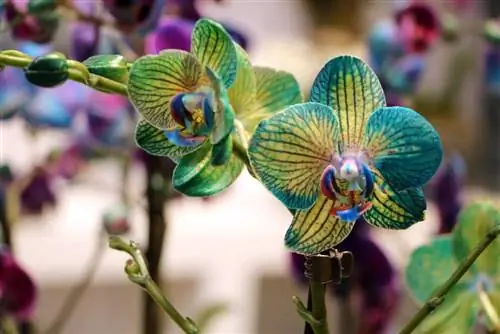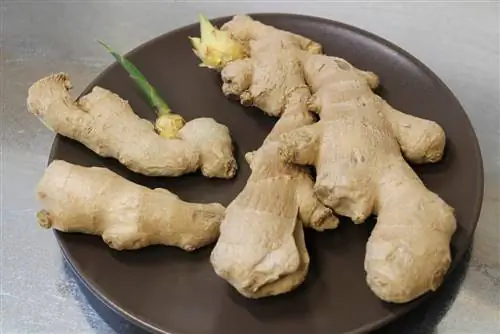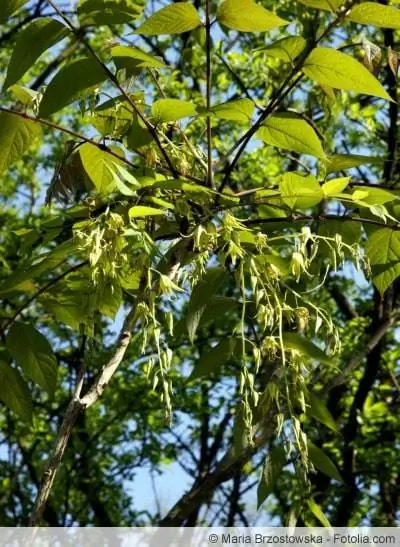- Author admin [email protected].
- Public 2023-12-17 03:39.
- Last modified 2025-06-01 06:48.
Especially because blue ginger is rather rare here, it is worth keeping this relatively easy-care rarity in your own home! The blue ginger, which is also called “Blue Ginger” or - depending on its origin - “Brazilian Ginger”, also comes from tropical Central and South America. The interesting, bright blue plant can now be found in many regions and is a beautiful ornamental plant.
Care
The care of blue ginger is overall uncomplicated, as it is rather modest in its requirements both in terms of light requirements and other care. The bright blue Brazilian beauty prefers partial shade and no waterlogging.
Sowing
It is not possible to plant blue ginger in your own garden by sowing, because so-called generative propagation cannot be carried out with this plant because it simply does not produce seeds.
Location
Due to its tropical origins, the plant is generally more suitable for indoor locations than outdoors. If you like, you can still keep the blue ginger on the terrace, in the garden or on the balcony from May - after the last night frosts - until October. The blue ginger feels comfortable in the winter garden all year round and it also thrives very well in bright indoor spaces. If the blue ginger is to find a place outdoors in summer, then it prefers a partially shaded location. Overall, the plant is both wind and heat tolerant. However, it should be slowly acclimated to the sun, especially after overwintering indoors, and should not be placed directly in the blazing spring sun.
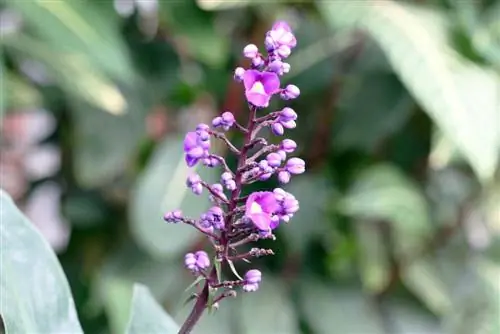
In winter, the blue ginger appreciates a bright place and a room temperature of around 15 °C, although this can fluctuate both up and down by around 5 °C. Under these conditions, the plant will produce new growth from April onwards. The plant can also tolerate a minimum temperature of 0 °C for a short time, for example if it was forgotten to move from the garden to the interior before a cold autumn night.
Location Requirements:
- in the winter garden or outdoors from May to October
- partially shaded location
- slow sun acclimation after wintering
- Bright location in winter with temperatures around 15 °C
Plants
When planting, blue ginger loves humus-rich soil that may contain coarse grains - for example lava grit or expanded clay or gravel. This interspersed substrate ensures the necessary looseness of the plant's soil. You should avoid using peat as a substrate additive in favor of more stable types of humus.
Repotting
Blue ginger usually opens in autumn and produces the first new shoots from April. Therefore, this plant should be repotted outside of its active phase, i.e. in late autumn or early spring. The plant is then placed in the new substrate during its resting phase and it does not have to invest energy in shoots and flowering or in switching to a new planter. However, repotting during the summer would cost the plant too much energy, which could ultimately affect the lush flowering.
Pouring
In summer, it is important to ensure that the soil moisture for blue ginger is constant and not too intense. If the plant sits in backwater for a longer period of time, the fleshy roots can rot because they are not sufficiently supplied with oxygen. In winter, the plant also needs consistent soil moisture, but this should be kept at a relatively low level in the cold season. Wilting leaves during the cold, low-light winter do not indicate a lack of water, because the perennials simply shrink and some of the leaves wilt. That's why you should never counteract wilting leaves in winter with more water.
Especially during the cool winter period, moisture and wetness promote rotting of the roots. If the edges of the leaves are just brown, then this is not a lack of water, but a sign that the air is too dry, as is often the case in heated rooms in winter. In this case, the leaves can be sprinkled moderately with low-lime water from a flower sprayer.
Pouring requirements
- water sparingly and regularly
- definitely not waterlogging
- If the edges of the leaves are brown, spray the leaves moderately with low-lime water
Care
Especially in summer, moderate but regular watering is an absolute must. The plant should be watered in the morning or evening. It is important to water slowly so that the plant only receives as much water as the substrate can absorb without causing undesirable waterlogging. If possible, no water should get on flowers and leaves at all.
Fertilize
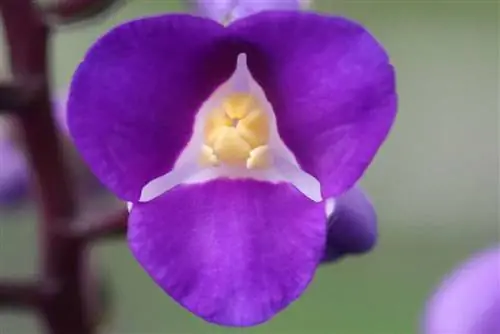
Blue ginger fertilization should take place from April to September. A complete fertilizer is used every seven to 10 days, which is available as a liquid product or as a water-soluble powder. Permanent fertilization with sticks over the warm season is also possible. In winter, the plant's fertilization is reduced so that the plant only receives additional fertilizer once or a maximum of twice a month from October to March.
Cutting
Basically, blue ginger is very modest when it comes to cutting. In general, it is enough to remove dried leaves from the plant. Unlike other plants, cutting the shoots of blue ginger does not result in beautiful branching, but rather just delayed flowering.
Wintering
While the blue ginger can live outdoors from May to October, it needs to go into winter quarters in a bright location with a temperature of around 15 °C from October to April at the latest.
Propagate
Blue ginger is propagated using cuttings or division, which is also known as vegetative propagation. For the vegetative propagation of the plant, so-called head cuttings about 10 to 15 cm long are cut off and planted individually in smaller pots or several in larger pots, which are filled with a substrate made of sowing soil and sand or pricking soil or a peat-sand mixture. The cuttings are then placed in a bright, but not intensely sunny and not too warm location and are always kept slightly moist. A warm soil from the location accelerates the rooting process of blue ginger.
Particularly good results when rooting tropical cuttings can be achieved in a heated indoor greenhouse that has a cover. A climate is created here that the blue ginger greatly appreciates because it creates optimal heat and humidity conditions.
Diseases
If the air is too dry in winter, the blue ginger responds with brown leaf edges, which you can spray the plant moderately with low-lime water. Otherwise, this tropical plant is robust against diseases.
Pests
In general, blue ginger is described as being very reliably pest-free. When problems of this kind arise, they are always caused by too much moisture and root rot, which weakens the plant. If the blue ginger is not kept too moist and without waterlogging and a humidity level of around 50 percent is maintained during wintering, it is relatively safe from pest infestation.
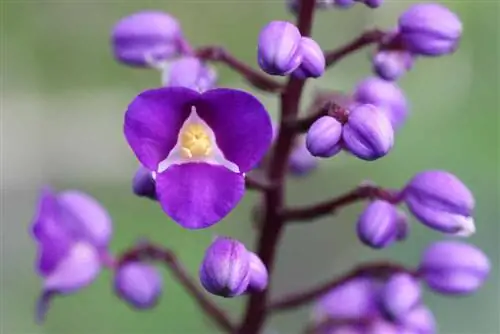
Frequently asked questions
Is blue ginger related to the ginger we know in the kitchen?
Even though the plant is called “blue ginger”, it does not belong to the family of so-called Zingiberaceae, i.e. the ginger family. Instead, blue ginger belongs to the Tradescantia family.
Where do I get the blue ginger?
Blue ginger is one of the more exotic plants that is not very common here. This plant is therefore unlikely to be found in traditional garden centers. The best way to get Blue Ginger is via the Internet. Auction houses or specific dealers for exotic plants can be helpful in obtaining this plant. Specialized dealers in particular are often happy to procure the plant upon request.
What you should know about blue ginger in brief
- Blue ginger usually develops in autumn, which makes it particularly good in the winter garden.
- Here you should make sure that it gets enough light, but is not in direct sunlight.
- It is best to place it in partial shade, where it is best kept and protected from excessive heat.
- In winter you should ensure that the blue ginger is not exposed to temperatures below 15 °C.
- You can remove the dried leaves in spring. However, pay attention to the shoots.
- It is particularly important to use nutrient-rich, i.e. humus-rich, very loose soil.
If these guidelines are met, there are no major problems with the blue ginger and it can find its place in the winter garden all year round, in a bright living room with the appropriate temperature or on the balcony in spring and summer or the terrace, as he also feels very comfortable there.


